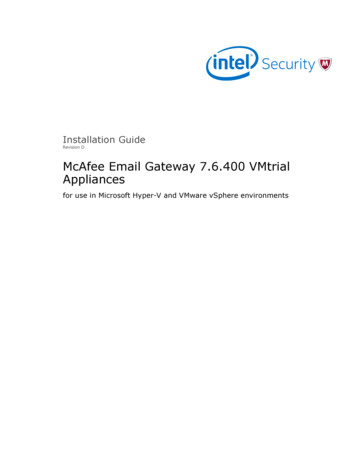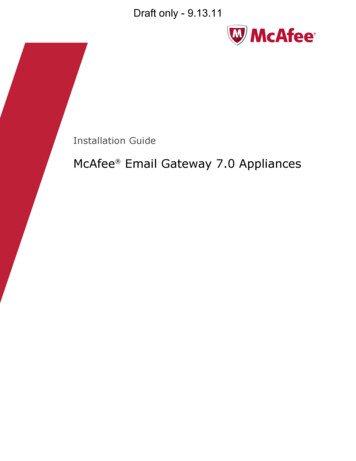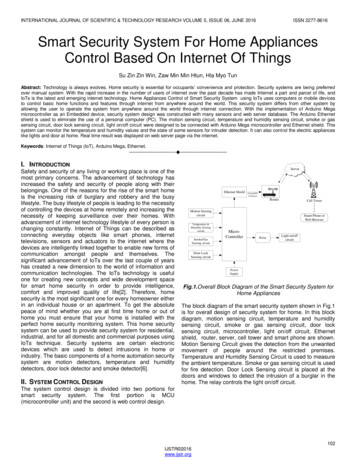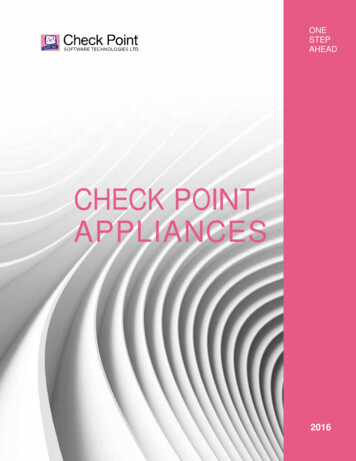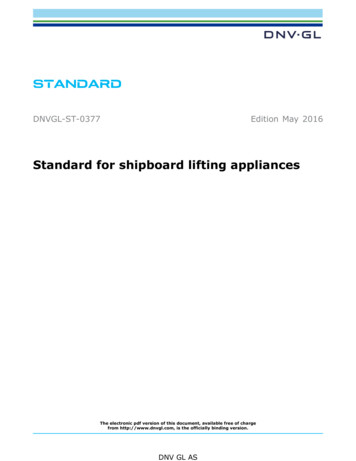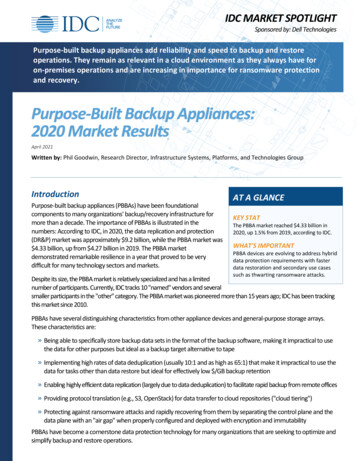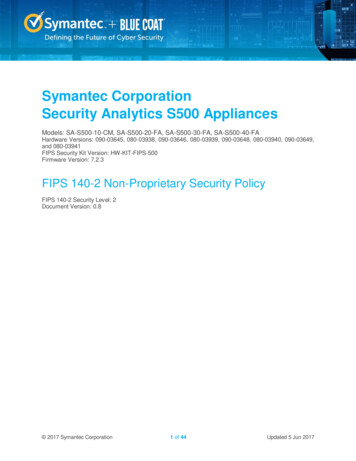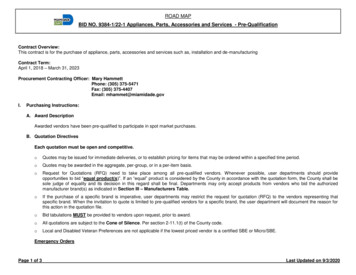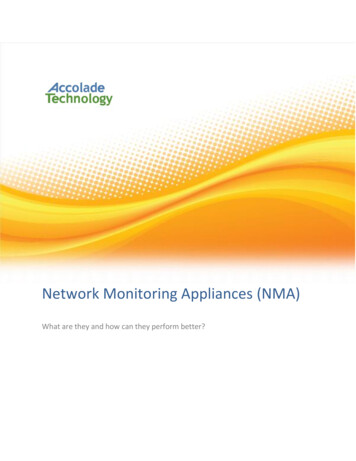
Transcription
Network Monitoring Appliances (NMA)What are they and how can they perform better?
IntroductionThe phrase “network monitoring appliance” is a generic term that can be used in many contextsand is often called by other names. In this paper we consider a network monitoring appliance(NMA) to be any hardware centric device that receives network packets from some other device(e.g. network TAP, Ethernet switch SPAN port) and then analyzes those packets with softwarefor some specific network, security or quality of service related purpose. Figure 1 provides ahigh level view of some typical NMAs and their general application categories.Figure 1: Network Monitoring Appliances (NMAs)The purpose of these appliances runs the gamut from tracing a hacker after a security breach, tonetwork troubleshooting, to measuring the quality of voice and video traffic. A common trait ofthese appliances is they are passive or work in “offline” mode. In other words, they receivepackets that have been replicated from the production network-typically by a network TAP orEthernet switch SPAN port-and therefore are not operating on live traffic.2 Page
There is a class of appliance called an “Intrusion Prevention System” or IPS that operates on livenetwork traffic and attempts to identify malicious activity (typically based on some signature orpattern that has been previously identified) and block it. A unique requirement for an in-line IPSis a bypass switch, which “fails open” so that live network traffic is not blocked if the appliancefails. While this type of device could certainly be considered an NMA, in this paper we are morefocused on NMAs that capture large volumes of traffic (often include local storage) in an offlinemode and do some deep software analysis on the captured traffic. With that definition in mind,an “Intrusion Detection System” (IDS) is more what we are focused on. IPS and IDS howeverare very closely related and sometimes people lump them together and just call them an IDPS.Alphabet SoupMarketing departments and industry analysts routinely coin new terms and related acronyms tospice up the conversation, but these can add confusion if not clearly understood. We will try todemystify some of these terms in order to provide a clearer picture of the market landscape.Network monitoring appliances (NMAs) are sometimes referred to as “probes” presumablybecause they are used to search into or thoroughly examine the packets which traverse acomputer network. While the term “probe” is still occasionally used to reference an NMA it isn’tthe most commonly used word and thus may not provide the clearest description.“Network sensor” is another term you might hear to refer to an NMA. This is a descriptive termand it is true that an NMA “senses” the state of network traffic. However, this term is notpreferred because it can be easily confused with a wireless network sensor that is used to monitorphysical or environmental conditions such as temperature, sound, or pressure.Sometimes network monitoring appliances are generically referred to as “tools”. This ispresumably because these appliances come in many flavors and perform various functions suchas troubleshooting, security or video quality analysis. This term however is perhaps too genericas it can be applied to almost any piece of hardware or software.Gartner has coined the term “Network Performance Monitoring and Diagnostics” (NPMD) andeven has a magic quadrant to rank vendors in this market. This term is lacking for a few reasons.First it largely ignores the security aspect of the network monitoring market in favor of thetroubleshooting or fault isolation aspects. And secondly it also overlaps with the applicationperformance monitoring (APM) market which is less about packet analysis and more abouttracking the end-user performance of application components. According to Gartner; “APMdiffers from NPMD primarily in its focus on monitoring the quality of the end-user's experiencevia application interactions across all application and infrastructure tiers, including, but not3 Page
limited to, the network perspective”. To further complicate the matter Gartner has also coined theterm “Application-Aware Network Performance Monitoring” (AA-NPM) which contains certainaspects of APM and is considered a subset of NPMD. All of these different categories seek toslice and dice the market across different dimensions but don’t seem to capture the high levelessence of what these products provide. Perhaps the easiest and most straightforward way tocapture the essence is simply as “network monitoring appliances”. These three words are plentydescriptive. The word appliance clearly communicates that we are referring to something that ishardware centric as opposed to pure software. Appliance evokes the image of something youpurchase from a vendor and install in a rack in your network which is precisely what you do withthese products. And finally the dictionary definition of the verb monitor is: “to watch, keep trackof, or check usually for a special purpose”. This definition clearly describes that these applianceswatch the traffic in a network; keep track of what is occurring in the network and all for a specialpurpose such as troubleshooting, security or video quality analysis.We will conclude with our concise definitionof a network monitoring appliance (NMA); ahardware centric device which capturespackets from a live network and analyzes themwith software for some specific network,security or quality of service related purpose.Network Packet Broker (NPB)A discussion of network monitoring appliances (NMAs) would not be complete without somemention of a relatively new category called “Network Packet Broker” (NPB). These deviceshave been known by various other names such as packet flow switches, matrix switches ornetwork monitoring switches. The last term is probably most descriptive because an NPB isbasically a switch that shunts traffic to various NMAs based upon some configured policies asshown in Figure 2.4 Page
Figure 2: Network Packet Broker (NPB)NPBs are used in modern enterprise and service provider networks for several reasons. First, dueto the sheer number of different NMAs that are being added to existing networks, providing anetwork TAP for each NMA is sometimes not feasible. And secondly the complexity andscalability requirement of some monitoring infrastructure has far exceeded the ability of Ethernetswitches to provide an adequate number of SPAN ports. These forces warrant a migrationtowards an additional networking monitoring layer that sits between the source of traffic (e.g.network TAP) and network monitoring appliances.How do I accelerate my network monitoring appliance?Most NMA vendors rely on industry standard servers from Cisco, Dell, HP, or Super Micro fortheir appliance hardware and spend most of their R&D dollars on software. This combination ofgeneric hardware and proprietary software is often not powerful enough to handle the deluge ofnetwork traffic these appliances receive. This is particularly true as vendors have to contend with10, 40 and now 100 gigabits of traffic on a single port.5 Page
There are different solutions to this conundrum but they are all bounded by at least threefundamental requirements: 1) The solution must fit in to an industry standard server, 2) must notrequire major modification to the vendor’s software and 3) must be cost effective.Accolade’s ANIC line of FPGA-based, hardware adapters meet these three requirements andmore. All ANIC adapters are fully PCIe compliant and thus fit seamlessly in to any industrystandard server. The adapters come with a well-defined API and their own device drivers whichfacilitates easy integration with any software application. And they are very cost effectivebecause they limit the need for horizontal server scaling; thereby saving appliance cost, rackspace and power.Furthermore, an FPGA-based ANIC adapter offers the following advantages over a standardNIC. Lossless packet capture – Each ANIC adapter has adequate onboard memory to absorbany size burst of traffic and therefore never drops a packet.Acceleration Functions – A variety of pre-processing or acceleration functions such aspacket filtering, flow classification and deduplication are performed in hardware.Future proof – An FPGA is programmable, so as a vendor’s needs evolve the ANICadapter can be reprogrammed (by Accolade engineers) to accommodate new offload andacceleration requirements.6 Page
Company ProfileAccolade is the technology leader in high performance, FPGA-based, lossless packet capture andapplication acceleration adapters. Accolade serves the global network appliance OEM market.Customers integrate the company’s ANIC adapters in to their network appliances in order to gainadvanced capabilities such as line rate packet capture, time stamping, packet filtering, and flowclassification. Established in 2003, Accolade Technology is a privately held company based inMassachusetts with additional offices in Silicon Valley, California and Atlanta, Georgia.Corporate Headquarters:Silicon Valley:South East U.S. Regional:124 Grove Street, Suite 315980 Mission Court,2997 Cobb Parkway,Franklin, MA 02038Fremont, CA 94539Atlanta, GA 30339T: 877.653.1261T: 877.793.3251T: 877.897.4833F: 208.275.4679www.accoladetechnology.com7 Page
Gartner has coined the term “Network Performance Monitoring and Diagnostics” (NPMD) and even has a magic quadrant to rank vendors in this market. This term is lacking for a few reasons. First it largely ignores the security aspect of the network monitoring market in favor of the troubleshooting or fault isolation aspects.

